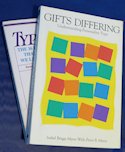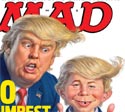
- About the MBTI
- Verify Your MBTI Type
- Personality Patterns
- MBTI Articles & Resources
- Article Directory for Educators & Students
- Books on Personality Types
- Emotional Intelligence & Personality Type
- Career Planning & MBTI
- MBTI Business Applications
- Lenore Thomson - Carl Jung Personality Type
- Site Map - Master Directory of All Articles
- MBTI Consultant Links
- Personality Type Workshops & Conferences
- Links to Other Type Websites
- Murder Mystery Business Theatre
- About Us
Educator & Student Guide to The MBTI ®, the Myers-Briggs Type Indicator, & Myers Briggs Personality Type.
Index to Articles on Personality Type |
|
|
 Note to Educators. Creating Internet web links to any of the pages on PersonalityPathways.com for course materials is permitted (and encouraged) without asking for my express permission. What would be problematic is copying the material and presenting it on another website (i.e. other than PersonalityPathways.com) or copying and distributing print versions of the material w/o my permission Let me know how PersonalityPathways.com can better help you provide online resources for your students on the MBTI ® & Myers Briggs Personality Type and its applications. |
|
Take our online self-scoring "Personality Test" and learn more about Personality Types. |
How common are each of the the 16 Personality Types?
|
Introductory Articles on the MBTI & Myers Briggs Personality Type
-
An Introduction to the MBTI & Myers Briggs ® Model of Personality Types
An introduction to Jung's model of psychological types as adapted by Isabel Myers in the development of the MBTI ® - the Myers-Briggs Type Indicator. Authored by Ross Reinhold, editor of PersonalityPathways.com and an experienced MBTI administrator and educator. -
About the Myers-Briggs Type Indicator - MBTI ®
An introduction to the basic concepts underlying the MBTI and its uses in education, industry, career development, and counseling. Authored by Peter Geyer, an internationally known and respected MBTI educator and authority on Carl Jung's Theory of Psychological Types. -
Myers Briggs Test * What is Your Myers Briggs Personality Type?
An online inventory to introduce students to the theory of Personality Types and the concepts behind the Myers-Briggs Type Indicator ®. Educators and MBTI administrators also use this as an informal personality test to verify the applicability of the scoring resulting from an administration of the Myers-Briggs Type Indicator. Authored by Ross Reinhold, an experienced MBTI administrator and educator, and editor of PersonalityPathways.com . -
Descriptions of the 16 Myers Briggs Personality Types
Descriptions of the characteristics of the 16 Myers Briggs Personality Types by Danielle Poirier, an internationally respected consultant and educator of applications of Personality Type. Danielle is also the creator and producer of a popular multi-media CD on Personality Type entitled "The Magnificent 16." -
How Myers Briggs Personality Types are Distributed in the Population
Two tables at the bottom of this page compare the distribution of MBTI Personality Types in the normal population with the distribution of Types in the leading professional membership organization for people having an interest in Personality Type.
* While commonly referred to as the Myers Briggs Test or the MBTI test, the MBTI ® is not a test but a personality inventory or instrument in which there are no right or wrong answers.
® MBTI, Myers-Briggs, Meyers Briggs, and Myers-Briggs Type Indicator are registered trademarks or trademarks of the Myers-Briggs Type Indicator Trust in the United States and other countries (aka meyer briggs or myers briggs).
Intermediate Articles on the MBTI & Personality Type
-
Personality Type Dynamics: Interpreting the Personality Type Code
An explaination of the rationale behind the arrangement of the letters of the four letter MBTI type code, including the concepts of dominant and auxiliary mental functions, the psychological attitudes of extraversion and introversion and the dynamics of interpreting the Myers' J and P type letters. -
Understanding the Characteristics & Relationships of the 16 Personality Types
The organization and relationships of the 16 Myers Briggs Personality Types are outlined according to 4 basic Personality Types and 8 secondary type groups. The Jung-Myers concepts of psychological mental functions is explained in more depth and how they relate to Introversion and Extraversion. Definitions are offered which may aid a person, whose MBTI type score is at or near the border between opposite preferences, in identifying which of the 16 Personality Types is their "best fit." -
The Hidden Letters of the Myers-Briggs MBTI Personality Types
We know that according to Isabel Myers and the Carl Jung model of Personality Type she expanded upon that "All people possess all of the Myers-Briggs preferences." So an INFP also has within its personality type pattern ESTJ. But how does this play out? Is it the same for each of the 16 types. This article explains how the hidden letters make a difference. The second page of the article, Patterns of Personality Type, presents a graphic image for each of the 16 Myers Briggs Personality Types that illustrate how the hidden letters or hidden mental functions and mental attitudes are arranged.
Advanced Articles on the MBTI, Carl Jung & Personality Type
-
Lenore Thomson on Carl Jung and Personality Type
Lenore Thomson is author of "Personality Type: An Owner’s Manual" and the former editor of the Jungian Journal Quadrant and a lecturer with the C.G. Jung Foundation in New York City. She is an internationally recognized authority on Jung's Theory of Psychological Type and an experienced psychotherapist. -
The Building Blocks of Personality Type
Review of a new book by Leona Haas and Mark Hunziker illustrates how Carl Jung's eight mental processes underlie the familiar Myers-Briggs Personality Types and the four letter personality type code. The book includes detailed examples and a nice set of appendices that will be of value to the serious student of personality type and practitioners who use Personality Type in their practices. -
The Faces of Personality Type Development
This article explores the duality inherent in Jung's model of Psychological Type and suggests a pattern of development that each Personality Type will tend to follow as a person matures. -
Emotional Intelligence, Emotions, Feeling & Personality Type
Emotional Intelligence and EQ instruments have become popular concepts and applications in education and business. While at first blush, emotional intelligence seems to refer to the Jung-Myers concept of Feeling judgment, it appears the relationship to Personality Type and the Jung-Myers typology is much more complex.
Articles on Applications of the MBTI & Personality Types
-
MBTI ® Educational Applications: Are They Really Problem Students?
Educators and authors Jane Kise and Beth Russell illustrate how they have used the Myers-Briggs Type Indicator - MBTI - and an understanding of Jungian & Myers Briggs Personality Type to assist teachers with reaching across boundaries to connect with a wider variety of student learning styles.
-
Career Choice and Career Development: Using the MBTI ® and Personality Type
Whether it is preparing for your first career, changing careers in mid-life, succeeding in your career, or actively engaging in a job search, an understanding of your Personality Type and research on the Myers-Briggs & MBTI can help your career development. Author Ross Reinhold is a qualified MBTI Administrator, a former Human Resources executive, and has several years of experience as a career planning and job search coach. -
Jung and Organization Development: A Powerful Model for Change Agents
Jan Yuill, an author and an organizational development consultant, describes a model of organizational intervention she developed based on the Jung-Myers-MBTI ® typology of personality. Her book - "Organizations Alive!" - offers an in depth look into how to use this model to enhance organizational change. -
The Practical Business Applications of the MBTI Myers-Briggs Personality Type Model
A former business owner and human resources executive reflects on some significant personal learnings in applying an understanding of Myers-Briggs Personality Type to relationships and practices in business. -
Transformational Leadership: Using the MBTI to Coach Leaders
The MBTI and Executive Leadership Coaching: Using the MBTI to Help Leaders Shape an Optimally Balanced Organizational Culture by Stanley D. Truskie, Ph.D. -
The 8 Colors of Exercise Fitness
An interview by Linda Berens of Suzanne Brue on the relationship of personality types and exercise.---Descriptions of the 8 Exercise Fitness Personalities Presidential Politics & Personality Types
Type Watching US Politics. Is how we vote and whom we vote for greatly influenced by our genetic make-up? Are we born with a predisposition to be a Republican?
-
Leadership Styles - Donald Trump & Hillary Clinton
Contrasting personality types (ESTP vs INTJ) create quite different leadership styles. Which is most appropriate for the job of President?
-
Introducing Bernie Sanders - INFP
In some ways, Bernie is like most other INFPs, but in other ways he is different - atypical. For Type-Watchers, The Bern provides insight into the complexity of an INFP.
-
Behind the Face of Donald Trump - ESTP
People cheer him, people hate him, people can't believe he is still in the Presidential race. For Type-Watchers, The Donald provides a fascinating look at the mind and personality of ESTP types. With most extraverts, what you see is what you get. But not really."
-
Donald Trump 2.0 - Evolving Temperament?
Since the election, The Donald seems much more gracious towards those who were in his enemies camp. Is this more razzle-dazzle selling us a "pig in a poke" or is it consistent with his ESTP Personality Type? -
High Tec Gender Gap & Personality Type
Former Google employee James Damore raised the question of gender differences explaining the difficulty of high tech employers like Google obtaining proportional representation of women in high tech jobs. What does the data on Personality Type offer for this dilemma.
Lindsay Shepherd - Diversity in Academia & Personality Type
Teaching Assistant Lindsay Shepherd's confrontation with University speech police and the possible role of personality type in creating the university environment.
 Experts Respond to Criticism of the MBTI and the "Myers-Briggs test "
Experts Respond to Criticism of the MBTI and the "Myers-Briggs test "

See More Books & Book Reviews Here
on the MBTI, Myers Briggs & Personality Types
- Information on MBTI ® Certification -
![]() CAPT - Center For Applications of Psychological Type . . . The Education and Research Foundation established by Isabel Myers and Mary McCaulley.
CAPT - Center For Applications of Psychological Type . . . The Education and Research Foundation established by Isabel Myers and Mary McCaulley.
© Published by Ross Reinhold & Reinhold Development 1997 - 2023
Privacy Policy About Us

